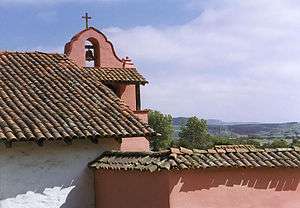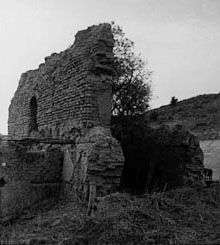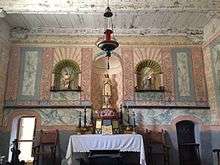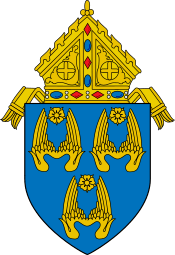La Purisima Mission
 La Purisima Mission | |
 Location of La Purisima Mission in California | |
| Location | 2295 Purisima Road, Lompoc, Santa Barbara County, California 93436 |
|---|---|
| Coordinates | 34°40′13.692″N 120°25′14.2206″W / 34.67047000°N 120.420616833°WCoordinates: 34°40′13.692″N 120°25′14.2206″W / 34.67047000°N 120.420616833°W |
| Name as founded | La Misión de La Purísima Concepción de la Santísima Virgen María[1] |
| English translation | The Mission of the Immaculate Conception of the Most Blessed Virgin Mary |
| Patron | The Immaculate Conception of the Most Blessed Virgin Mary[2] |
| Nickname(s) | "The Linear Mission"[3] |
| Founding date | December 8, 1787[4] |
| Founding priest(s) | Father Fermín Lasuén[5] |
| Founding Order | Eleventh[2] |
| Headquarters of the Alta California Mission System | 1815–1819[6] |
| Military district | Second [7] |
| Native tribe(s) Spanish name(s) |
Chumash Purisimeño |
| Native place name(s) | Laxshakupi, 'Amuwu[8] |
| Baptisms | 3,255[9] |
| Marriages | 1,029[9] |
| Burials | 2,609[9] |
| Secularized | 1834[2] |
| Returned to the Church | 1874[10] |
| Governing body | California Department of Parks and Recreation |
| Current use | Museum |
| Designated | 1970 |
| Reference no. | #NPS-70000147 |
| Designated | 1970 |
| Reference no. | #340 |
| Website | |
| http://www.lapurisimamission.org | |

Mission La Purisima Concepción, or La Purisima Mission (originally La Misión de La Purísima Concepción de la Santísima Virgen María, or The Mission of the Immaculate Conception of the Most Blessed Virgin Mary) is a Spanish mission in Lompoc, California. It was established on December 8, 1787 (the Feast of the Immaculate Conception, hence the mission's name) by the Franciscan order. The original mission complex south of Lompoc was destroyed by an earthquake in 1812, and the mission was rebuilt at its present site several miles to the northwest.
The mission is part of the larger La Purísima Mission State Historic Park, part of the California State Parks system, and along with Mission San Francisco de Solano is one of only two of the Spanish missions in California that is no longer under the control of the Catholic Church. It is currently the only example in California of a complete Spanish Catholic mission complex, and was designated a National Historic Landmark in 1970.
History
Mission La Purisima was originally established at a site known to the Chumash people as Algsacpi and to the Spanish as the plain of Rio Santa Rosa, one mile south of Lompoc. (During the mission period, the Chumash spoke the Purisimeño language.)[11] The Viceroyalty of New Spain made an exception to the rule that no California mission was to be established within seven miles of any pueblo in Las Californias, as Lompoc was so small.
By 1803, the Mission Indians population had increased, by Indian Reductions, to 1,436 Chumash people. At the mission there were also 3,230 cattle, 5,400 sheep, 306 horses, and 39 mules. In the same year, there was a harvest of 690 fanegas of wheat, corn and beans (a fanega equaling about 220 pounds).
An earthquake on December 21, 1812, severely damaged the mission buildings. New buildings were constructed four miles east of the pueblo at their present location, which was known to the Chumash as Amúu, and to the Spanish as La Cañada de los Berros, now part of the reconstructed La Purísima Mission State Historic Park.[12] Ruins of the original mission are at 508 South F Street, near East Locust Avenue in Lompoc, California.
After Mexico won the Mexican War of Independence in 1823, Spanish funding ceased to the Santa Barbara Presidio. Many soldiers at the mission who were no longer being paid by the new Mexican government took out their frustrations on the local Chumash Indians. After a soldier apparently beat an Indian at nearby Mission Santa Inés, the Chumash Revolt of 1824 occurred at that mission. It spread to La Purisima Mission, where the Chumash people took over the mission for one month until more soldiers arrived from Monterey Presidio. Eventually, the Chumash lost their hold on the mission with many leaving the mission soon there after. However, many of the Indians who had sought refuge in the neighboring mountains during the revolt returned to the mission.

Following independent Mexico's secularization of the Alta California missions from 1834 to 1843, the buildings of La Purisima Mission were abandoned, and the lands were granted Rancho Ex-Mission la Purisima. By 1934, only nine of the buildings remained intact.
In the 20th century, the Civilian Conservation Corps (CCC) pledged to restore the mission if enough land could be provided to convert it into a historic landmark. The Catholic Church and the Union Oil Company donated sufficient land for the CCC to proceed with the restoration. The nine buildings as well as many small structures and the original water system were fully restored with the mission's dedication occurring on December 7, 1941, the same day the United States entered World War II. Today, La Purisima Mission is the only example in California of a complete mission complex.
La Purísima Mission State Historic Park
La Purisima Mission is now part of the La Purísima Mission State Historic Park within the California State Parks System. With a visitor center and guided tours, the historic park is maintained by the California Department of Parks and Recreation (DPR). La Purisima is located in Lompoc, in the county of Santa Barbara, California.
Historic designations
- National Register of Historic Places #NPS-78000775 – original La Purisima Mission site.
- National Register of Historic Places #NPS-70000147 – La Purisima Mission State Historic Park.
- California Historical Landmark #928 – original La Purisima Mission site.
- Juan Bautista de Anza National Historic Trail – a designated Historic Site on the route of this National Park Service United States National Historic Trail
See also
- Spanish missions in California
- USNS Mission Purisima (AO-118) – a Buenaventura Class fleet oiler built during World War II.
- List of National Historic Landmarks in California
Notes
- ↑ Leffingwell, p. 79
- 1 2 3 Krell, p. 202
- ↑ Ruscin, p. 97
- ↑ Yenne, p. 104
- ↑ Ruscin, p. 196
- ↑ Yenne, p. 186
- ↑ Forbes, p. 202
- ↑ Ruscin, p. 195
- 1 2 3 Krell, p. 315: as of December 31, 1832; information adapted from Engelhardt's Missions and Missionaries of California.
- ↑ Krell, p. 202: The property was subsequently sold in 1874 due to its dilapidated state, and acquired by the State of California in 1935.
- ↑ "Purisimeño". Survey of California and Other Indian Languages. Retrieved 2012-07-22.
- ↑ "History: 1813–1834". La Purisima Mission.
References
- Anderson, Zachary (2014). Discovering Mission La Purísima Concepción. ISBN 9781627130943.
- Forbes, Alexander (1839). California: A History of Upper and Lower California. Smith, Elder and Co., Cornhill, London.
- Jones, Terry L. and Kathryn A. Klar (eds.) (2007). California Prehistory: Colonization, Culture, and Complexity. Altimira Press, Landham, MD. ISBN 0-7591-0872-2.
- Krell, Dorothy (ed.) (1979). The California Missions: A Pictorial History. Sunset Publishing Corporation, Menlo Park, CA. ISBN 0-376-05172-8.
- Leffingwell, Randy (2005). California Missions and Presidios: The History & Beauty of the Spanish Missions. Voyageur Press, Inc., Stillwater, MN. ISBN 0-89658-492-5.
- Paddison, Joshua (ed.) (1999). A World Transformed: Firsthand Accounts of California Before the Gold Rush. Heyday Books, Berkeley, CA. ISBN 1-890771-13-9.
- Ruscin, Terry (1999). Mission Memoirs. Sunbelt Publications, San Diego, CA. ISBN 0-932653-30-8.
- Yenne, Bill (2004). The Missions of California. Thunder Bay Press, San Diego, CA. ISBN 1-59223-319-8.
External links
- California State Parks: Official La Purísima Mission State Historic Park website
- La Purisima Mission.org website
- La Purisima Mission tour, admission, and event venue information
- Historical Tour of Mission La Purisima (11 minute video by Evva Vail)
- Elevation & Site Layout sketches of the Mission proper
- The Missions of California – History and restoration of California's 11th mission
- Purisima Mission Early photographs, sketches, land surveys of La Purisima Mission, via Calisphere, California Digital Library
- Early History of the California Coast, a National Park Service Discover Our Shared Heritage Travel Itinerary
- Official U.S. National Park Service Juan Bautista de Anza National Historic Trail website
- Howser, Huell (December 8, 2000). "California Missions (103)". California Missions. Chapman University Huell Howser Archive.
- Howser, Huell (December 8, 2000). "Missions Gardens Visit (109)". California Missions. Chapman University Huell Howser Archive.
| Wikimedia Commons has media related to Mission La Purísima Concepción. |
